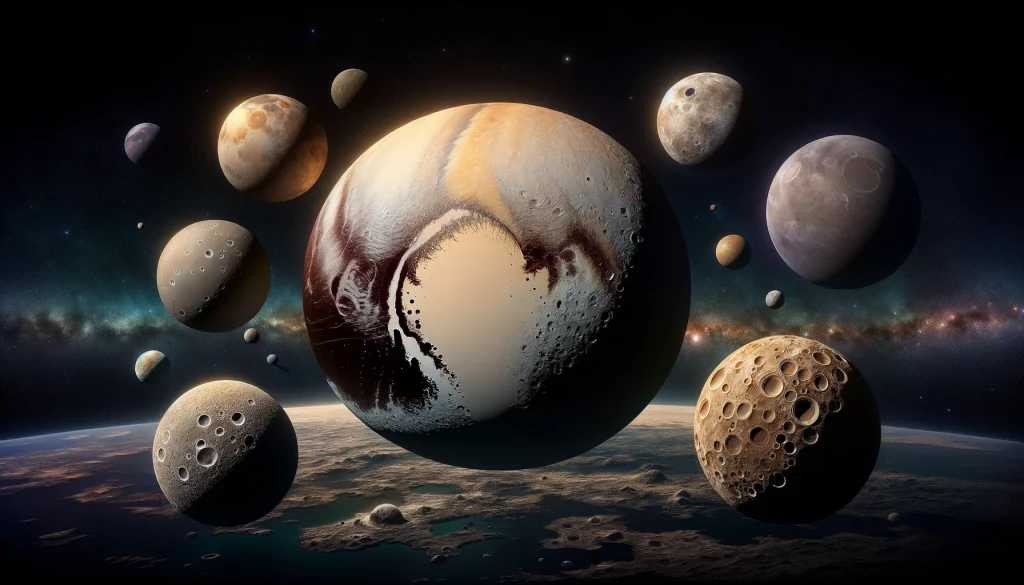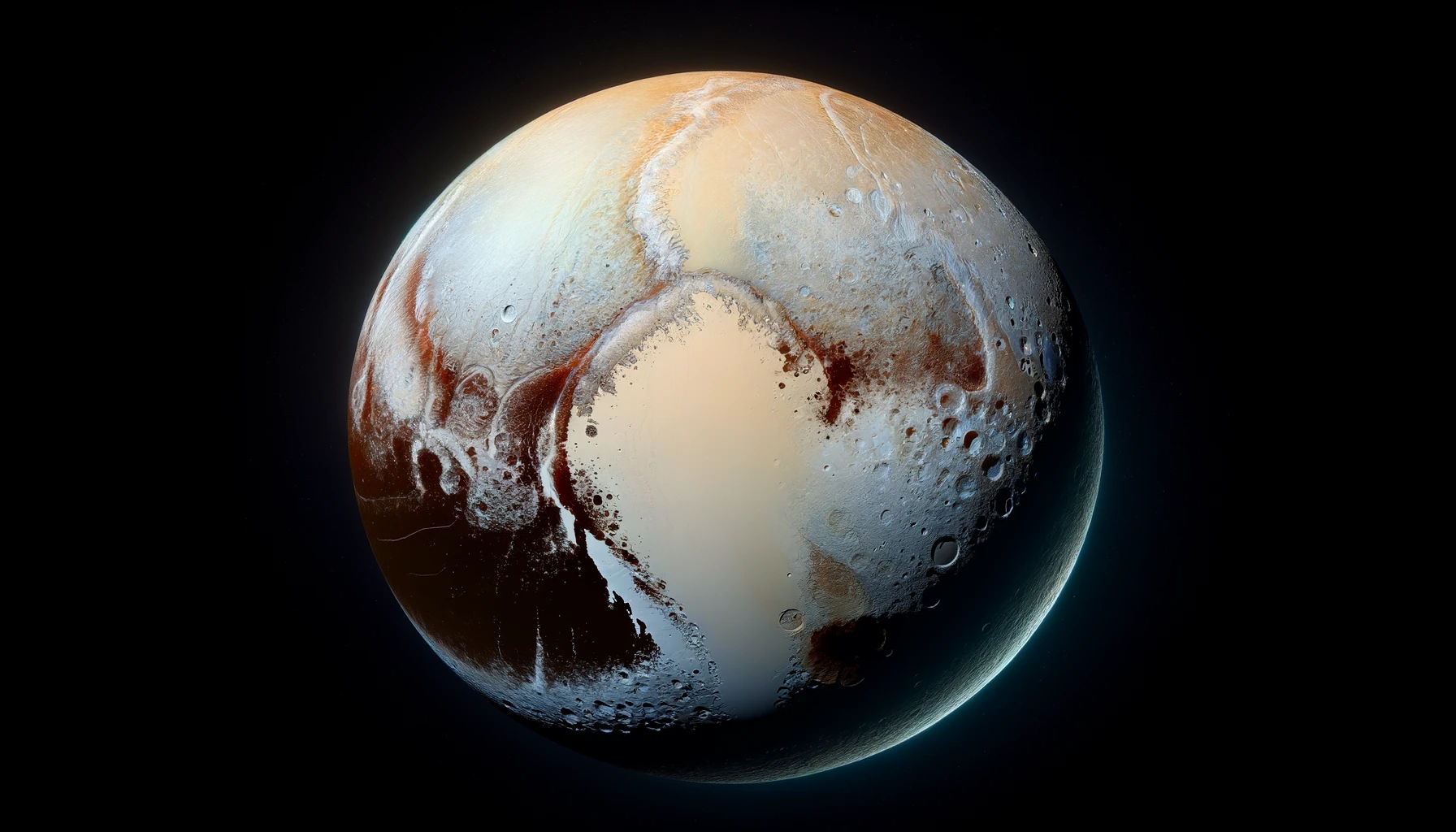Pluto’s story is one of discovery, reclassification, and ongoing scientific exploration. In 1930, Clyde Tombaugh made a groundbreaking discovery – a small, icy world beyond Neptune that was initially hailed as our ninth planet. For over 80 years, Pluto held this prestigious title, capturing the imaginations of astronomers and the public alike.
However, the discovery of other objects in the outer reaches of our solar system began to challenge Pluto’s planetary status. These newfound objects, collectively known as Kuiper Belt Objects (KBOs), shared many similarities with Pluto in terms of size and composition. As more KBOs were discovered, the question arose: could Pluto truly be a planet if it wasn’t unique in its orbital neighborhood?
Unveiling the Kuiper Belt: A Crowded Neighborhood of Icy Worlds
The discovery of Pluto wasn’t the end of the story, but rather the beginning of a new chapter in our exploration of the outer solar system. Beyond Neptune lies a vast region known as the Kuiper Belt, a celestial treasure trove filled with countless icy objects. These KBOs, as they are called (Kuiper Belt Objects), are remnants of the early solar system’s formation, composed primarily of frozen ices like water, methane, and ammonia.
The discovery of Eris in 2005 threw Pluto’s planetary status into further question. Eris, a KBO residing in the distant Kuiper Belt, was surprisingly similar to Pluto in size. This newfound celestial body, with a mass potentially even larger than Pluto, highlighted the need for a clearer definition of what constitutes a planet. The question fell to the International Astronomical Union (IAU), the international governing body for astronomy, to establish a new classification system.
Redefining “Planet”: The Dawn of Dwarf Planets
In 2006, the International Astronomical Union (IAU) tackled the question of planetary classification and introduced a new category: the dwarf planet. This new designation aimed to bring clarity to the classification of celestial bodies beyond Neptune, particularly in light of the growing number of discovered KBOs.
The IAU established three criteria that a celestial body must meet to be considered a full planet:
- It must be in orbit around the Sun. This excludes any object that simply travels through our solar system, like comets or asteroids.
- It must have enough mass to be in hydrostatic equilibrium. Simply put, this means the object’s gravity is strong enough to overcome its rigid body forces and pull itself into a roughly spherical shape.
- It must have cleared the neighborhood around its orbit. This is where Pluto’s classification came into question. Unlike planets, which tend to have relatively clear orbital paths, Pluto shares its orbital neighborhood with numerous other KBOs. Because it doesn’t dominate its orbital region, Pluto fell short of the third criteria and was reclassified as a dwarf planet.
A Dwarf Planet Full of Surprises
Despite being reclassified as a dwarf planet, Pluto remains a fascinating world with unique characteristics. While small in size, measuring only about two-thirds the width of the United States, Pluto holds a surprising icy composition. Frozen water ice makes up a significant portion of its mass, along with methane and ammonia ices. Interestingly, Pluto’s surface even boasts a heart-shaped feature composed of nitrogen ice, a quirk that has captured the public’s imagination.
Pluto isn’t a solitary world. It presides over a retinue of five known moons, the largest of which is Charon. Unlike most moon size comparisons, Charon is surprisingly large relative to Pluto. In fact, the diameter of Charon is roughly half that of Pluto, giving the system a binary appearance in some respects. This unique characteristic further fuels scientific curiosity about Pluto and its moons.

Pluto’s atmosphere adds another layer of intrigue. Though thin and only present when Pluto is closer to the Sun, it holds a surprising composition. Frozen nitrogen makes up the majority, but methane, carbon monoxide, and trace amounts of other gases are also present. Studying this tenuous atmosphere can offer clues about Pluto’s internal composition and its interaction with the solar wind.
Pluto’s Unconventional Path and Seasons
Pluto’s journey around the Sun is far from ordinary. Unlike most planets that trace out nearly circular orbits, Pluto follows a highly elliptical path. This eccentricity means its distance from the Sun varies greatly throughout its 248-year orbit. At times, Pluto ventures closer to the Sun than Neptune, before retreating back to the farthest reaches of our solar system. This extreme elliptical orbit has a significant impact on the amount of sunlight Pluto receives, influencing its surface temperature and atmospheric pressure.
Adding another layer of complexity is Pluto’s axial tilt. Unlike Earth’s tilt of about 23 degrees, Pluto’s axis is tilted a dramatic 120 degrees relative to its orbital plane. This extreme tilt results in drastic seasonal variations across Pluto’s surface. As Pluto travels around the Sun, different parts of its surface are bathed in sunlight for extended periods, while others experience long stretches of darkness. These vast seasonal shifts likely play a role in the surface features and atmospheric composition observed on Pluto.
The reasons behind Pluto’s tilted axis remain an area of ongoing scientific investigation. One possibility is a giant impact early in Pluto’s history, similar to the theory proposed for Uranus’ tilt. A collision with another celestial body could have disrupted Pluto’s original spin, leaving it tilted on its side. Further study is needed to solidify this theory or explore alternative explanations for Pluto’s unusual tilt.
The New Horizons Mission
In 2015, humanity’s understanding of Pluto took a giant leap forward with the arrival of the New Horizons mission. This groundbreaking spacecraft, launched in 2006, became the first ever to fly by Pluto and its moons, offering an unprecedented glimpse into this distant world.
New Horizons’ close encounter with Pluto was a resounding success. The spacecraft collected a treasure trove of data and high-resolution images, revealing details about Pluto’s surface features, compositional variations, and the presence of glaciers made from frozen nitrogen ice. The data also provided valuable insights into Pluto’s tenuous atmosphere, confirming the presence of methane, nitrogen, and carbon monoxide.
New Horizons didn’t stop at Pluto itself. The mission also obtained detailed observations of Pluto’s largest moon, Charon, revealing a surprisingly complex and geologically active world. The data continues to be meticulously analyzed by scientists, offering new discoveries and a deeper understanding of the Pluto system’s formation and evolution.
Even after its historic flyby, New Horizons continues its journey deeper into the Kuiper Belt. Scientists are hopeful that ongoing analysis of the Pluto data, along with future observations of other KBOs, will shed even more light on the origins and diversity of these icy worlds.
A Legacy of Discovery: Pluto’s Enduring Impact
Pluto’s journey from planet to dwarf planet sparked a revolution in our understanding of the outer solar system. Studying Pluto and the Kuiper Belt has not only revealed new and fascinating worlds but also provided valuable insights into the formation of our solar system.
The discovery of numerous KBOs with similar compositions to Pluto suggests that these icy objects may be remnants of the solar system’s early building blocks. By studying the diversity of KBOs and dwarf planets, we can gain a better understanding of the conditions that existed during the solar system’s formation and the types of objects that coalesced beyond the frost line.
Furthermore, the presence of moons like Charon orbiting Pluto raises intriguing possibilities. Icy moons, such as those found around Jupiter and Saturn, are known to harbor subsurface oceans that could potentially support life as we know it. While the frigid surface conditions on Pluto itself make life unlikely, the possibility of subsurface oceans on Pluto or other KBOs with internal heat sources cannot be entirely ruled out.
The exploration of Pluto and the Kuiper Belt is far from over. Continued observations and future missions dedicated to studying dwarf planets and KBOs hold immense potential. By unraveling the secrets of these distant worlds, we can not only expand our knowledge of the solar system’s diversity but also shed light on the potential for habitable environments beyond our own planet. Pluto’s story serves as a reminder that scientific discovery is a continuous process, and even objects once relegated to the fringes of our solar system can hold the key to unlocking the universe’s mysteries.
Beyond Pluto: Unveiling the Mysteries of the Kuiper Belt
Pluto may be the most famous resident of the Kuiper Belt, but it’s far from alone. This vast icy realm harbors a multitude of dwarf planets and KBOs, each offering a unique puzzle piece for astronomers to explore. Eris, the dwarf planet that challenged Pluto’s planetary status, resides in the distant Kuiper Belt, along with other noteworthy objects like Haumea and Makemake. These dwarf planets showcase a surprising diversity in size, composition, and even the presence of icy rings.
The quest to unveil the mysteries of the Kuiper Belt continues. Currently, the European Space Agency’s (ESA) spacecraft Rosetta, primarily focused on comet exploration, is venturing further into the Kuiper Belt, offering valuable observations of these distant objects. Additionally, there are ongoing proposals for dedicated missions to explore KBOs in more detail, with some missions aiming to return samples for further analysis.
As we delve deeper into the Kuiper Belt, the study of dwarf planets like Pluto holds immense significance. These icy worlds, once considered on the fringes of our solar system, are now recognized as valuable time capsules preserving information about the solar system’s formation. Understanding their diversity in composition, internal structure, and potential for hidden oceans can provide crucial insights into the broader story of planetary evolution and the potential for habitable environments beyond the traditional realm of planets.
Pluto’s story, from its discovery as a planet to its reclassification as a dwarf planet, reminds us that scientific exploration is a journey of discovery and refinement of our knowledge. The numerous dwarf planets and KBOs waiting to be explored in the Kuiper Belt promise to unveil a treasure trove of information about the origins of our solar system and the potential for hidden worlds harboring environments conducive to life. The future of space exploration looks to these distant realms, and Pluto’s legacy serves as a stepping stone on this exciting path of scientific discovery.
